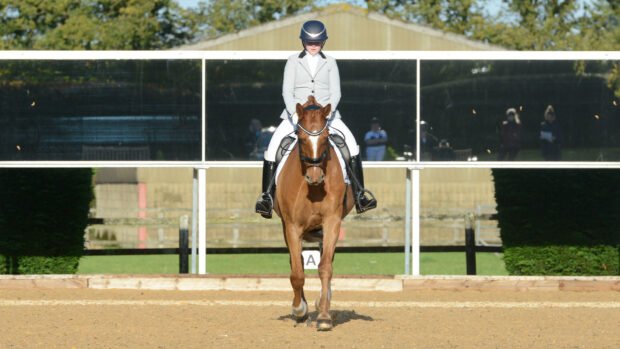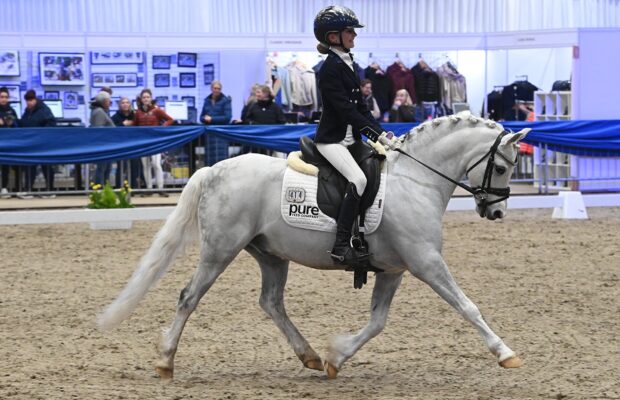Watching the likes of the Lemieux National Dressage Championships is always inspiring, seeing riders and horses at the very top of their game and producing stunning performances up and down the levels. But the idea of going home and trying to transfer that magic to our own horses can be somewhat daunting. Luckily, international rider and trainer Anna Ross is on hand to provide practical training tips and advice for producing better dressage from even the most ordinary of horses.
Anna Ross structures her advice around the scales of training: rhythm, suppleness, contact, impulsion, straightness and collection, providing useful nuggets of information relating to each.
1, How can I tell if my horse is supple?
“You, and a judge, can whether a horse is supple enough by whether it can hold the rhythm as you ride the lines in the test,” says Anna. “In order to have suppleness, you need to maintain the rhythm throughout. Look to see if you can see your horse’s inside eye, ear and also his inside nostril – as that will tell you whether he is tilting his head.”
Anna suggests including lateral work in your training, such as leg yield and half-pass to improve suppleness, but points out the key difference between the two exercises.
“In leg yield you have to have flexion, but not bend; you flex the horse to the right but move the horse to the left. Leg yield helps to make a horse supple, but lots of people bend the neck too much and the horse falls out to the other side.
“Half pass on the other hand has bend – all the way through the body of the horse in the direction in which it is moving.”
2, How can I teach an unmotivated horse to go forwards?
“Getting a horse to go forward is all about your personal electricity,” says Anna. “You need to be quick with your legs – on, off, on, off – in order to encourage your horse to get quicker in his work.
“To build impulsion, ride lots of transitions, going forward and back within the pace, time after time,” Anna recommends.
“And if you have a really unmotivated horse where you put your leg on and nothing happens, I recommend taking them for a good gallop!”
3, What is straightness and why does it matter?
Straightness is a topic that can often cause confusion, as Anna acknowledges.
“Asking for straightness while riding circles seems like a different language, but horsey straightness is about the hind feet following the prints of the front feet,” explains Anna.
“The reason straightness matters is because it comes before collection in the scales of training. If you jump and down off just one leg, you won’t be able to jump as high as you could if you jumped off two legs. In the same way, we need the horse to be straight so it can use its maximum power for the more advanced movements, like piaffe. And the more effort a horse makes, the more likely it is to wobble and lose some straightness.”
4, How can I teach my horse to lengthen his stride?
To encourage a horse to learn to lengthen his trot stride and ultimately develop an extended trot, Anna recommends a technique she often uses with younger horses at her training and sales centre in Devon, Elite Dressage.
“If we really want to invigorate a horse, or improve their extensions, ride alongside another that will extend, and ask for some lengthened strides at the same time to tap in the horse’s natural herd instinct,” advises Anna. “It’s much more fun than kicking!”
5, How can I achieve collection?
“Collection comes last in the scales of training; this is all about power and your horse being able to sit on his hind legs and become more expressive,” says Anna, explaining that only by building up and combining those elements further down the scale can collection be achieved.
“It’s by building up all the other things that makes your horse into a fancy little number. If you can get all your ducks in a line, even the least motivated horse will stop being such hard work,” she says.
You might also be interested in…

Anna Ross: New-look Nationals are ‘a bigger, brighter showcase for our sport’

Charlotte Dujardin shares her plans for Mount St John Freestyle

The scales of training explained for horse riders of all levels

How to stop your horse rushing — and other training gems from Laura Tomlinson
Olympic gold medallist Laura Tomlinson shares some invaluable training tips and tricks to incorporate into your own schooling

Subscribe to Horse & Hound magazine today – and enjoy unlimited website access all year round
Horse & Hound magazine, out every Thursday, is packed with all the latest news and reports, as well as interviews, specials, nostalgia, vet and training advice. Find how you can enjoy the magazine delivered to your door every week, plus options to upgrade your subscription to access our online service that brings you breaking news and reports as well as other benefits.




